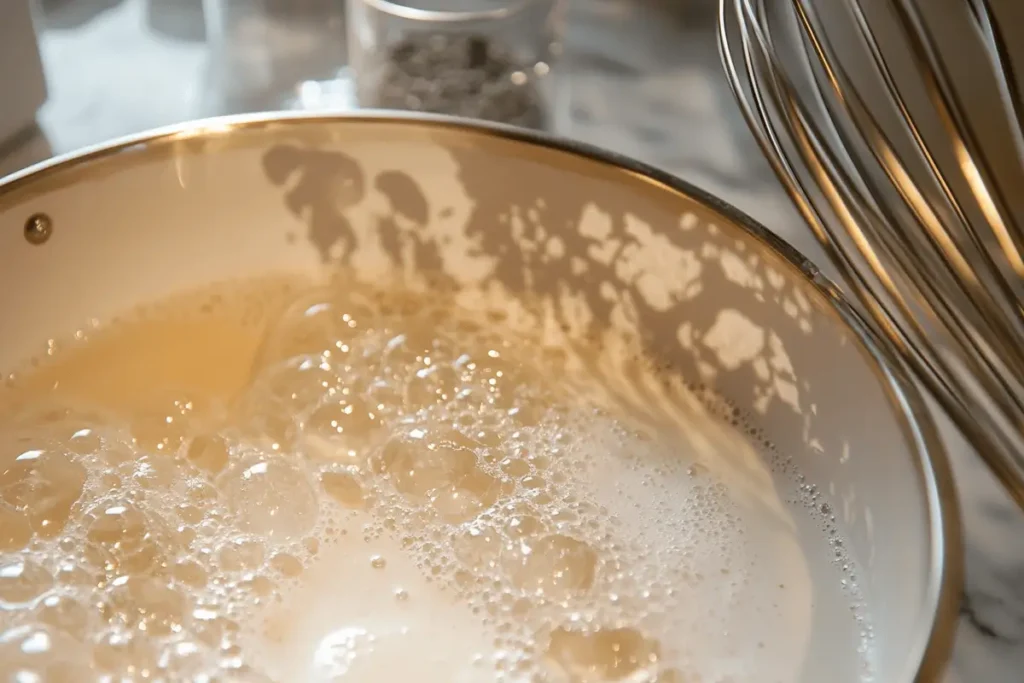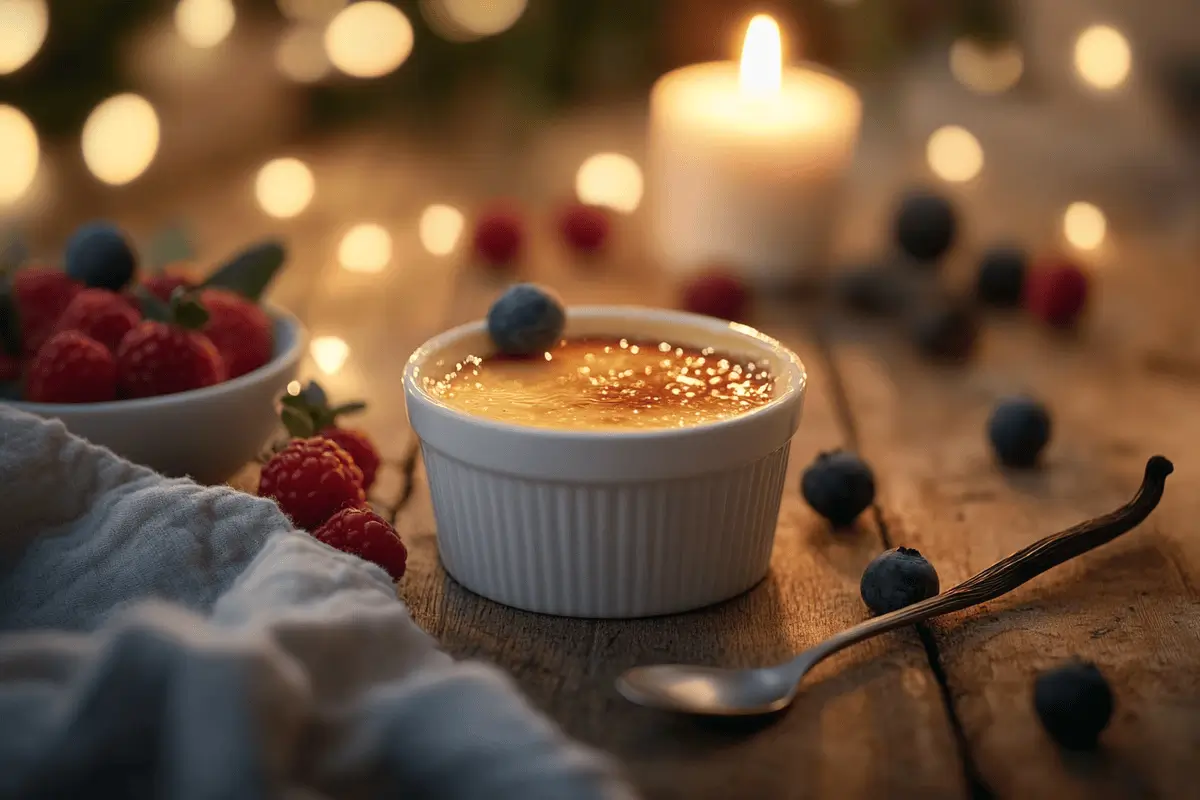Crème brûlée is one of those desserts that feels like pure magic: a creamy custard base with a thin, glass-like layer of caramelized sugar that shatters under your spoon. But what’s the secret to making this elegant French classic at home? From perfecting the custard to mastering the caramelized sugar topping, every step has its nuances. In this article, we’ll break down each stage, giving you practical tips and tricks to ensure your crème brûlée is flawless every time. Let’s dive into the secrets of this exquisite dessert.
The Foundations of Crème Brûlée
What is Crème Brûlée?
Crème brûlée, meaning “burnt cream” in French, is a dessert beloved for its delicate texture and dramatic topping. At its core, this classic treat consists of just four ingredients: heavy cream, egg yolks, sugar, and vanilla. The magic lies in how these simple elements transform into a silky custard crowned with crunchy, caramelized sugar. A blend of science and artistry, crème brûlée is both straightforward and nuanced—easy to make but just as easy to mess up.
Historically, crème brûlée has been a staple in French cuisine since the 17th century, often served as a luxurious finish to lavish meals. Despite its fancy reputation, this dessert is surprisingly achievable at home if you know a few essential techniques.
The Simplicity of Ingredients: Heavy Cream, Egg Yolks, Sugar, and Vanilla
The beauty of crème brûlée lies in its simplicity. With just a handful of ingredients, each one plays a starring role. Start with heavy cream—it’s the backbone of the custard, creating that luscious, creamy texture. Egg yolks provide richness and structure, while granulated sugar adds sweetness and aids in caramelizing the top.
Vanilla is the soul of this dessert. Whether you use vanilla extract, vanilla bean paste, or fresh vanilla beans, it infuses the custard with warm, aromatic notes. For variations, you can experiment with other flavors like chocolate, espresso, or citrus, but the classic vanilla custard remains a favorite worldwide.
By understanding the importance of these foundational elements, you’re already on your way to mastering crème brûlée. Up next, we’ll explore how to prepare the custard base to perfection.
Mastering the Custard Base
High-Quality Ingredients: Why They Matter
The secret to crème brûlée lies in the quality of its ingredients. With so few components, there’s no room to hide—so choose the best you can find. Opt for heavy cream with a rich fat content, as it’s crucial for achieving that signature silky texture. For sweetness, stick to fine granulated sugar, which dissolves seamlessly into the mixture.
When it comes to vanilla, the choice is yours: pure vanilla extract, fragrant vanilla bean paste, or the seeds from a fresh vanilla pod. Each brings its own depth of flavor, elevating your dessert from ordinary to extraordinary. If you’re considering a twist, high-quality chocolate or fresh citrus zest can make wonderful additions, but start with the classic for a foolproof approach.
The Art of Whipping Egg Yolks and Sugar
Achieving the perfect custard starts with whipping the egg yolks and sugar together. This step creates a creamy, pale-yellow base that’s essential for a smooth texture. Use a whisk or a mixer to beat the mixture until it thickens slightly and turns a lighter shade. This process ensures the sugar dissolves completely, leaving no granules behind.
Incorporating air at this stage helps the custard maintain its luscious consistency during baking. However, be cautious not to over-whisk; too much air can cause bubbles in the mixture, which might lead to uneven cooking.
Scalding the Cream for Perfect Texture
Before combining the cream with the yolks, it needs to be scalded. Scalding involves heating the cream until just before it boils—look for tiny bubbles forming around the edges of your saucepan. This step not only infuses the cream with warmth but also enhances its ability to blend smoothly with the eggs.
Pouring overly hot cream directly into the egg mixture can cook the eggs prematurely, leading to scrambled custard. Instead, we’ll explore tempering in Part 3, which is vital for avoiding this common pitfall.

Techniques for Preparing the Custard
Tempering Egg Yolks Without Scrambling
One of the most critical steps in mastering crème brûlée is tempering. To avoid ending up with scrambled eggs, you need to introduce the hot cream to the egg mixture gradually. Start by drizzling in a small amount of cream while whisking constantly. This gentle process raises the temperature of the eggs slowly, preventing them from cooking too quickly.
Once tempered, you can add the remaining cream in a steady stream. The result? A velvety custard base ready for baking.
Removing Air Bubbles for a Silky Finish
After combining the ingredients, you might notice a layer of bubbles on the surface. These won’t harm the flavor but can mar the visual appeal. To remove them, skim the surface with a spoon or gently tap the ramekins on the counter. This extra step ensures a flawless finish once baked.
Even Portioning in Ramekins
Even cooking starts with even portions. Use a measuring cup or a kitchen scale to divide the custard equally among your ramekins. Uneven filling can lead to inconsistencies in texture and cooking times, so precision is key.
Once portioned, your custards are ready for the oven. But before baking, don’t forget to check the next section on using a water bath for the perfect bake.
For a unique take on crème brûlée, you might explore recipes like Crab Brûlée, which adds a savory twist to the classic dessert. This delightful variation showcases how versatile the brûlée technique can be.
Baking the Perfect Crème Brûlée
Positioning in the Oven: The Role of Even Heating
Baking crème brûlée is where precision really matters. To ensure even cooking, position your ramekins in the center of the oven. This placement balances the heat from both the top and bottom elements, preventing over-browning or undercooked custards.
Before preheating, adjust your oven rack to the middle. This small adjustment guarantees your custards will bake evenly, which is key to achieving that silky-smooth texture. For ovens with hot spots, rotating the baking pan halfway through cooking can also help.
Using a Water Bath: The Key to Consistency
The secret to crème brûlée’s creamy custard lies in baking it gently. A water bath—or bain-marie—is essential. By insulating the ramekins in a pan of water, you create a stable environment that prevents overheating and cracking.
To set up your water bath, place the filled ramekins into a deep baking dish. Carefully pour hot water into the dish, ensuring it reaches halfway up the sides of the ramekins. Adding water once the dish is on the oven rack minimizes spills.
Remember, patience is vital here. The custards should bake at a low temperature for about 30-40 minutes until they are just set with a slight jiggle in the center. Overbaking will lead to a grainy texture—something you definitely want to avoid.
Preventing Cracks: Cooling and Chilling Techniques
Once the custards are out of the oven, resist the urge to dig in right away. Let them cool in the water bath for 20-30 minutes to stabilize their structure. Afterward, transfer the ramekins to a wire rack and cool completely at room temperature.
For the best results, refrigerate the custards for at least 4 hours or, ideally, overnight. Chilling allows the flavors to meld and the custard to firm up perfectly.
Achieving the Signature Caramelized Sugar Topping
How to Sprinkle and Torch Sugar Like a Pro
The caramelized sugar topping is what makes crème brûlée so special. To achieve that iconic crack, sprinkle an even layer of granulated sugar over the chilled custards. For a smooth finish, sift the sugar through a fine-mesh sieve.
Using a kitchen torch, melt the sugar evenly by moving the flame in small, circular motions. Keep the torch at a moderate distance to avoid scorching any one spot. You’re aiming for a golden-brown crust that’s crisp without tasting burnt.
If you don’t have a torch, don’t worry! You can use your oven’s broiler. Place the ramekins on a baking sheet under the broiler for a few minutes, keeping a close eye to prevent burning.

Avoiding Burnt Sugar for the Ideal Balance of Flavor
The trick to perfect caramelization is control. Burning the sugar will add an unpleasant bitterness, overshadowing the custard’s delicate flavors. To avoid this, work quickly and evenly, adjusting the flame as needed.
Once the sugar cools, it hardens into a brittle shell that contrasts beautifully with the creamy custard underneath. This combination of textures is one of the most beloved features of crème brûlée.
For more delicious recipe ideas, check out MultyRecipes for creative twists on classic desserts and savory delights. You might find inspiration in their unique brûlée variations to elevate your cooking skills.
Frequently Asked Questions (FAQs)
How Do You Know When Crème Brûlée is Done Baking?
Determining when crème brûlée is perfectly baked can feel tricky, but the key is to look for a slight jiggle. The custard should be mostly set, with a slight wobble in the center when you gently shake the ramekin. Avoid overbaking, as this can lead to a grainy texture. Once out of the oven, the custards will firm up as they cool, achieving that luxurious creaminess you’re aiming for.
Can You Make Crème Brûlée Without a Torch?
Yes, you can! While a kitchen torch is the most convenient way to caramelize the sugar topping, the oven broiler is a great alternative. Simply place the chilled custards under the broiler and watch closely as the sugar melts and browns. Rotate the ramekins as needed for even caramelization, but be cautious—sugar can burn quickly.
What Makes Crème Brûlée Fail?
The most common reasons for failure include overheating the custard, skipping the water bath, or uneven sugar caramelization. By carefully following each step, you can avoid these pitfalls and uncover what is the secret to crème brûlée: patience and precision.
How Long Can You Store Crème Brûlée?
Crème brûlée can be stored in the refrigerator for up to three days. Cover the ramekins with plastic wrap to preserve freshness, but always caramelize the sugar just before serving for the best texture.
Expert Tips and Tricks for Perfect Crème Brûlée
Common Mistakes and How to Avoid Them
Even experienced bakers can struggle with crème brûlée, but knowing the most frequent mistakes can help you avoid them. One major issue is overheating the cream while scalding, which can cause curdling. Always heat the cream gently and remove it as soon as bubbles appear around the edges.
Another common error is skipping the water bath. This step is non-negotiable—it ensures even cooking and prevents cracking. Finally, over-whisking the egg yolks can introduce excess air, leading to an uneven custard texture. Keep your whisking controlled and gentle.
Customizing Flavors: Vanilla Bean, Chocolate, and More
One of the joys of crème brûlée is its versatility. While classic vanilla is a timeless favorite, you can customize the flavor to suit your preferences. Try infusing the cream with fresh lavender, espresso, or cinnamon sticks for a unique twist. For chocolate lovers, a rich cocoa version is an indulgent treat.
Citrus zest, like orange or lemon, also adds a refreshing brightness to the custard. With so many possibilities, the base recipe is a canvas for your creativity.
Scaling the Recipe for Large Gatherings
Crème brûlée is an impressive dessert for entertaining, but scaling it for a crowd requires careful planning. Use larger baking dishes if individual ramekins aren’t practical, but adjust baking times accordingly. Additionally, consider preparing the custards a day in advance to save time on the day of your event.
Remember, the sugar topping should always be caramelized just before serving to maintain its delightful crunch. By mastering these techniques, you’ll confidently serve this dessert for any occasion.
With these tips and tricks, you now have all the tools to uncover what is the secret to crème brûlée. Whether perfecting the classic version or experimenting with new flavors, your next crème brûlée will surely impress.
Pairing Crème Brûlée with the Perfect Accompaniments
The Importance of Balance in Pairings
Crème brûlée is already a star dessert, but pairing it with the right accompaniments can elevate the experience. The creamy custard and crisp caramelized topping create a luxurious texture and flavor contrast. To enhance this dessert further, think about balance—light and fresh flavors complement the richness beautifully.
Fresh berries, such as raspberries or strawberries, are a classic choice. Their tartness cuts through the creaminess, providing a refreshing counterpoint. Alternatively, a dollop of whipped cream or a drizzle of fruit coulis adds both visual appeal and flavor harmony.
For those who enjoy a more indulgent touch, consider serving crème brûlée alongside buttery shortbread or biscotti. These crisp treats echo the caramelized sugar topping, creating a delightful textural pairing.
Variations to Elevate Your Crème Brûlée Game
Innovative Flavors to Try
While the classic vanilla crème brûlée is timeless, why not explore creative variations? Infused flavors are an excellent way to make the dessert your own. For instance, adding matcha powder to the custard introduces earthy notes and a stunning green hue. Alternatively, chai spices like cardamom and cinnamon bring a cozy warmth perfect for cooler months.
If you’re a chocolate lover, consider a dark chocolate crème brûlée. Mixing high-quality cocoa into the custard creates a decadent dessert that’s rich yet balanced. Citrus lovers might enjoy adding orange or lemon zest for a zippy twist.
Texture Variations: Beyond the Basics
What is the secret to crème brûlée that surprises most people? It’s how versatile the recipe is in terms of texture. You can tweak the dessert to suit different preferences. For a lighter finish, incorporate whipped cream into the custard base. If you’re aiming for an extra-crispy topping, use raw sugar instead of granulated—it caramelizes beautifully under the torch.
For a completely different spin, you can even experiment with savory versions. Imagine a crab or parmesan brûlée served as an appetizer. These innovative twists showcase how the brûlée technique transcends traditional boundaries.
Whether you stick with tradition or venture into creative territory, crème brûlée is a dessert that rewards patience and experimentation. By pairing thoughtfully and exploring new variations, you’ll uncover even more layers to what is the secret to crème brûlée. With these tips, you’re well on your way to mastering this elegant classic in all its forms.

